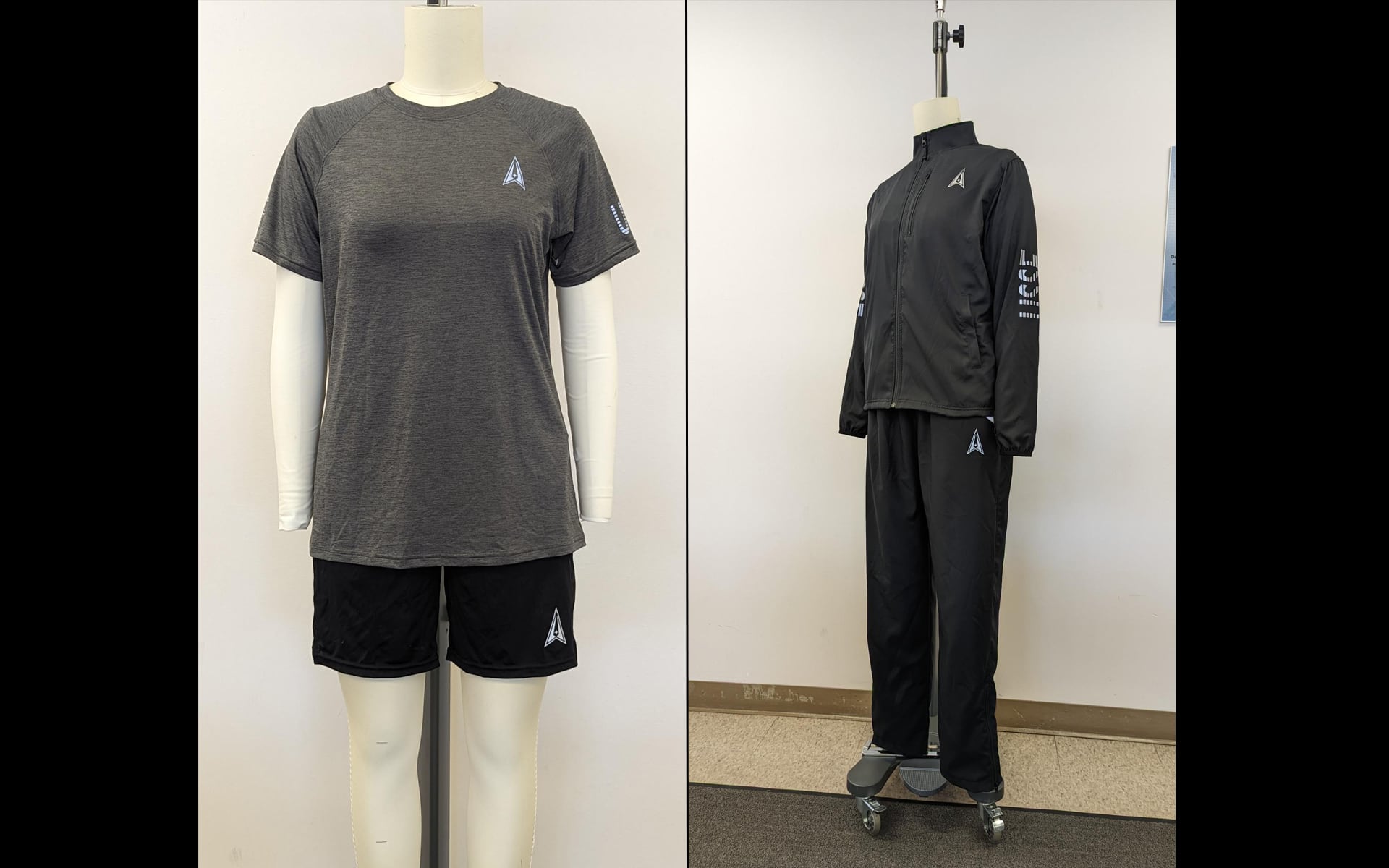This story was updated Dec. 21 at 2 p.m. to include new information from the Air Force on additional uniform items.
The Air Force’s new physical training uniforms are slated to hit shelves in March, bringing airmen a fresh set of workout gear nearly two years later than initially promised.
Their debut will mark the first major update to the service’s athleticwear in almost two decades, aiming to make airmen more comfortable during their sweat sessions.
The ensemble includes a blue-gray T-shirt emblazoned with “Air Force” in reflective lettering across the back, two pairs of navy-colored shorts and a navy tracksuit.
Service spokesperson Master Sgt. Deana Heitzman confirmed the uniforms are coming in a Dec. 7 email.
“Modernized [PT gear] will feature a revised fit, updated materials and fabric,” she said. “Our airmen drove all improvement efforts.”
Troops had expected new uniforms to go on sale in October 2022. But the rollout slowed amid a global textile shortage and other supply chain issues, like aging factory equipment and a dearth of workers, Heitzman said.
The delay left airmen wondering what had become of their new threads as a requirement to wear them in 2026 crept closer.
While the current and future uniforms look nearly identical, the latest iteration adds a pair of breathable, moisture-wicking shorts designed for runners. The clothing line is also available in men’s and women’s sizes, rather than unisex, for a better fit.
“Our main requirement … was to develop a PT uniform that people really wanted to wear and is as good as, if not better than, commercially available athleticwear,” Tracy Roan, chief of the Air Force Uniform Office, said in 2021. “The new uniform now includes all of the great performance features that you find in athleticwear today.”
The uniform boasts soft, quick-drying material that helps curb sweat and odor. That’s not all it eliminates: No longer will the jacket make the notorious “swish-swish” sound that annoys many airmen with every step.
The jacket also promises to be less bulky, with a chest pocket for holding small items like cards and keys.
Along with the running shorts, which have a shorter inseam and mesh side panels, airmen will have the option to don longer, all-purpose shorts with zippered pockets.
Two more clothing items are in the pipeline as well. Wear testing has wrapped on a long-sleeve shirt that is expected to become available in winter 2025, Air Force spokesperson Laurel Falls said Dec. 21. The service will also continue to refine a new hoodie after testers complained its fabric was too stiff. Airmen are not required to wear the long-sleeve shirt or hoodie as part of the uniform.
Developing and testing the new athleticwear cost $158,000, Heitzman said.
Airmen must wear the uniforms during PT tests and commander-led exercise events like fun runs, though units often break that rule to sport their own workout clothes instead. The Air Force is still mulling when to begin enforcing the requirement, Heitzman said.
Some social media users on forums like Reddit have noted that even when the uniforms do arrive, they’re unlikely to wear them more than a few times a year.
“Had a buddy testing it out, they look... basically the same but apparently feel much much better,” one Redditor said in September. “Not that it matters though since 90% of squadrons just [do] PT in civvy shorts and a squadron shirt anyways, and the other days are just self-PT.”
Airmen aren’t the only ones waiting for better workout clothes to drop.

The Space Force’s first service-specific PT uniform will also become available to trainees at boot camp starting in March, and to the rest of the field later in the year, spokesperson Maj. Tanya Downsworth said.
The service unveiled its designs for shirts, shorts, jackets and pants, featuring its delta logo, in September 2021. It’s unclear how much the Space Force, which spun off from the Air Force in 2019, has spent to develop separate clothing as it defines a unique service culture.
The Department of the Air Force designs its garments in-house, while consulting with the activewear industry to create fabrics that mimic those on the rack at a sporting goods store.
Military uniforms must be made in the U.S. under a 1941 law passed to support domestic suppliers and create American jobs. Today, the rule blocks the Pentagon from purchasing mass-produced shirts, shorts and jackets from major athleticwear retailers, like Under Armour and Nike, that churn out their threads overseas.
The restriction also means it takes much longer for the military to issue new workout gear than it would take to purchase clothes in bulk from an existing retail line, or for troops to swing by a mall.
Even when the new uniforms go on sale, it may take a while for them to make it into service members’ closets.
“Air Force service uniform orders are currently experiencing delays,” reads a notice on the Army & Air Force Exchange Service website. “The Defense Logistics Agency has stock shortages on multiple men’s and women’s service uniforms. We apologize for the inconvenience and appreciate your patience.”
Not all attempts to revamp military workout gear have crossed the finish line.
The Marine Corps recently scrapped its own yearslong quest to produce a new set of workout gear, citing “more urgent defense needs.”
“The Marine Corps is prioritizing programs that better focus on taking care of Marines and USMC modernization,” service spokesperson Morgan Blackstock said.
Rachel Cohen is the editor of Air Force Times. She joined the publication as its senior reporter in March 2021. Her work has appeared in the Washington Post, the Frederick News-Post (Md.), Air and Space Forces Magazine, Inside Defense, Inside Health Policy and elsewhere.





